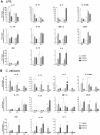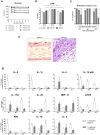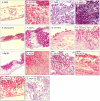Pathogenesis of Candida albicans infections in the alternative chorio-allantoic membrane chicken embryo model resembles systemic murine infections
- PMID: 21603634
- PMCID: PMC3094387
- DOI: 10.1371/journal.pone.0019741
Pathogenesis of Candida albicans infections in the alternative chorio-allantoic membrane chicken embryo model resembles systemic murine infections
Erratum in
- PLoS One. 2011;6(6). doi:10.1371/annotation/1912450a-b5a7-4dbe-bc2a-cd93579fb0dd
Abstract
Alternative models of microbial infections are increasingly used to screen virulence determinants of pathogens. In this study, we investigated the pathogenesis of Candida albicans and C. glabrata infections in chicken embryos infected via the chorio-allantoic membrane (CAM) and analyzed the virulence of deletion mutants. The developing immune system of the host significantly influenced susceptibility: With increasing age, embryos became more resistant and mounted a more balanced immune response, characterized by lower induction of proinflammatory cytokines and increased transcription of regulatory cytokines, suggesting that immunopathology contributes to pathogenesis. While many aspects of the chicken embryo response resembled murine infections, we also observed significant differences: In contrast to systemic infections in mice, IL-10 had a beneficial effect in chicken embryos. IL-22 and IL-17A were only upregulated after the peak mortality in the chicken embryo model occurred; thus, the role of the Th17 response in this model remains unclear. Abscess formation occurs frequently in murine models, whereas the avian response was dominated by granuloma formation. Pathogenicity of the majority of 15 tested C. albicans deletion strains was comparable to the virulence in mouse models and reduced virulence was associated with significantly lower transcription of proinflammatory cytokines. However, fungal burden did not correlate with virulence and for few mutants like bcr1Δ and tec1Δ different outcomes in survival compared to murine infections were observed. C. albicans strains locked in the yeast stage disseminated significantly more often from the CAM into the embryo, supporting the hypothesis that the yeast morphology is responsible for dissemination in systemic infections. These data suggest that the pathogenesis of C. albicans infections in the chicken embryo model resembles systemic murine infections but also differs in some aspects. Despite its limitations, it presents a useful alternative tool to pre-screen C. albicans strains to select strains for subsequent testing in murine models.
Conflict of interest statement
Figures








Similar articles
-
Two unlike cousins: Candida albicans and C. glabrata infection strategies.Cell Microbiol. 2013 May;15(5):701-8. doi: 10.1111/cmi.12091. Epub 2013 Jan 14. Cell Microbiol. 2013. PMID: 23253282 Free PMC article. Review.
-
Comparative virulence of Candida auris with Candida haemulonii, Candida glabrata and Candida albicans in a murine model.Mycoses. 2018 Jun;61(6):377-382. doi: 10.1111/myc.12754. Epub 2018 Mar 14. Mycoses. 2018. PMID: 29460345
-
Comparison of pathogenesis and host immune responses to Candida glabrata and Candida albicans in systemically infected immunocompetent mice.Infect Immun. 2001 Aug;69(8):5046-55. doi: 10.1128/IAI.69.8.5046-5055.2001. Infect Immun. 2001. PMID: 11447185 Free PMC article.
-
A Candida albicans Strain Expressing Mammalian Interleukin-17A Results in Early Control of Fungal Growth during Disseminated Infection.Infect Immun. 2015 Sep;83(9):3684-92. doi: 10.1128/IAI.03057-14. Epub 2015 Jul 6. Infect Immun. 2015. PMID: 26150537 Free PMC article.
-
Candida and candidaemia. Susceptibility and epidemiology.Dan Med J. 2013 Nov;60(11):B4698. Dan Med J. 2013. PMID: 24192246 Review.
Cited by
-
Small but crucial: the novel small heat shock protein Hsp21 mediates stress adaptation and virulence in Candida albicans.PLoS One. 2012;7(6):e38584. doi: 10.1371/journal.pone.0038584. Epub 2012 Jun 7. PLoS One. 2012. PMID: 22685587 Free PMC article.
-
Two unlike cousins: Candida albicans and C. glabrata infection strategies.Cell Microbiol. 2013 May;15(5):701-8. doi: 10.1111/cmi.12091. Epub 2013 Jan 14. Cell Microbiol. 2013. PMID: 23253282 Free PMC article. Review.
-
Divergent Approaches to Virulence in C. albicans and C. glabrata: Two Sides of the Same Coin.Int J Mol Sci. 2019 May 11;20(9):2345. doi: 10.3390/ijms20092345. Int J Mol Sci. 2019. PMID: 31083555 Free PMC article. Review.
-
Antifungal Therapy: New Advances in the Understanding and Treatment of Mycosis.Front Microbiol. 2017 Jan 23;8:36. doi: 10.3389/fmicb.2017.00036. eCollection 2017. Front Microbiol. 2017. PMID: 28167935 Free PMC article. Review.
-
A Host-Pathogen Interaction Screen Identifies ada2 as a Mediator of Candida glabrata Defenses Against Reactive Oxygen Species.G3 (Bethesda). 2018 May 4;8(5):1637-1647. doi: 10.1534/g3.118.200182. G3 (Bethesda). 2018. PMID: 29535147 Free PMC article.
References
-
- Odds FC. Candida and Candidosis. London: Baillière Tindall; 1988.
-
- Pappas PG, Rex JH, Lee J, Hamill RJ, Larsen RA, et al. A prospective observational study of candidemia: epidemiology, therapy, and influences on mortality in hospitalized adult and pediatric patients. Clin Infect Dis. 2003;37:634–643. - PubMed
-
- de Repentigny L. Animal models in the analysis of Candida host-pathogen interactions. Curr Opin Microbiol. 2004;7:324–329. - PubMed
Publication types
MeSH terms
Substances
LinkOut - more resources
Full Text Sources
Medical
Molecular Biology Databases

